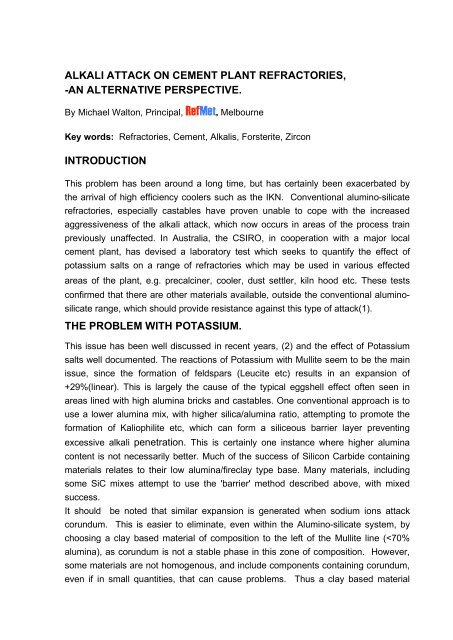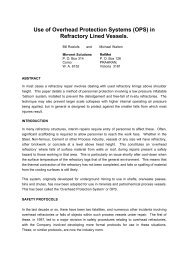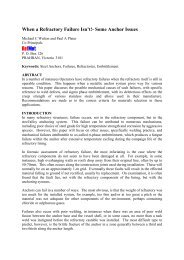ALKALI ATTACK ON CEMENT PLANT REFRACTORIES ... - RefMet
ALKALI ATTACK ON CEMENT PLANT REFRACTORIES ... - RefMet
ALKALI ATTACK ON CEMENT PLANT REFRACTORIES ... - RefMet
You also want an ePaper? Increase the reach of your titles
YUMPU automatically turns print PDFs into web optimized ePapers that Google loves.
<strong>ALKALI</strong> <strong>ATTACK</strong> <strong>ON</strong> <strong>CEMENT</strong> <strong>PLANT</strong> <strong>REFRACTORIES</strong>,<br />
-AN ALTERNATIVE PERSPECTIVE.<br />
By Michael Walton, Principal, <strong>RefMet</strong>, Melbourne<br />
Key words: Refractories, Cement, Alkalis, Forsterite, Zircon<br />
INTRODUCTI<strong>ON</strong><br />
This problem has been around a long time, but has certainly been exacerbated by<br />
the arrival of high efficiency coolers such as the IKN. Conventional alumino-silicate<br />
refractories, especially castables have proven unable to cope with the increased<br />
aggressiveness of the alkali attack, which now occurs in areas of the process train<br />
previously unaffected. In Australia, the CSIRO, in cooperation with a major local<br />
cement plant, has devised a laboratory test which seeks to quantify the effect of<br />
potassium salts on a range of refractories which may be used in various effected<br />
areas of the plant, e.g. precalciner, cooler, dust settler, kiln hood etc. These tests<br />
confirmed that there are other materials available, outside the conventional aluminosilicate<br />
range, which should provide resistance against this type of attack(1).<br />
THE PROBLEM WITH POTASSIUM.<br />
This issue has been well discussed in recent years, (2) and the effect of Potassium<br />
salts well documented. The reactions of Potassium with Mullite seem to be the main<br />
issue, since the formation of feldspars (Leucite etc) results in an expansion of<br />
+29%(linear). This is largely the cause of the typical eggshell effect often seen in<br />
areas lined with high alumina bricks and castables. One conventional approach is to<br />
use a lower alumina mix, with higher silica/alumina ratio, attempting to promote the<br />
formation of Kaliophilite etc, which can form a siliceous barrier layer preventing<br />
excessive alkali penetration. This is certainly one instance where higher alumina<br />
content is not necessarily better. Much of the success of Silicon Carbide containing<br />
materials relates to their low alumina/fireclay type base. Many materials, including<br />
some SiC mixes attempt to use the 'barrier' method described above, with mixed<br />
success.<br />
It should be noted that similar expansion is generated when sodium ions attack<br />
corundum. This is easier to eliminate, even within the Alumino-silicate system, by<br />
choosing a clay based material of composition to the left of the Mullite line (
would be preferred. This would restrict the alumina content to below 50%. Although<br />
not proven by this testwork, theoretically, the materials under discussion above could<br />
also alleviate the problems associated with Sodium ion attack. The worst case<br />
scenario for a kiln system, is where there are significant levels of both alkali species<br />
present. In this case it will be necessary to avoid alumino-silicates altogether.<br />
OTHER MATERIALS<br />
Two materials submitted for testwork were not conventional alumino-silicates, nor<br />
contained SiC/clay etc. One was based on Forsterite, the second on Zircon. The<br />
former, of Norwegian origin, was tested as both brick and castable. While there was<br />
some expected differences in their physical properties, neither form showed<br />
significant chemical attack, while retaining the original dimensions of the test block.<br />
Forsterite is a mixture of magnesium silicate and fayalite. The refractories tested had<br />
a typical chemical composition as follows:<br />
MgO : 52%, Si0 2 : 40%, FeO : 6%<br />
The test report (3) on the Forsterite materials stressed that, although extensively<br />
penetrated by alkali species, no deleterious phases were formed, thus no expansion<br />
was measured.<br />
A very similar result was obtained with a Zircon based Low Cement castable of<br />
Australian manufacture. This material is a mixture of naturally arising zircon and other<br />
synthetic alumino-silicate materials. The product's chemistry (typical) is as follows:<br />
A l 2 0 3 : 56%, Si0 2 : 18%, Zr0 2 : 23%, FeO :
The Forsterite castable, available in a similar gunning grade, is chemically bonded<br />
and thus applicable for use where calcium aluminate cement content needs to be<br />
minimised.<br />
C<strong>ON</strong>CLUSI<strong>ON</strong>S<br />
Unique test procedures developed for an Australian cement plant have confirmed<br />
that both Olivine/Forsterite and Zircon based products are suitable for use in high<br />
alkali (Potassium) environments. These products showed no deleterious reactions,<br />
as would be found with high alumina materials. Specifically, no excessive expansion<br />
was produced under the test conditions, indicating unwanted reactions were not<br />
occurring. These materials also possess thermal properties which make them more<br />
user friendly than those containing SiC.<br />
REFERENCES.<br />
1) Stone N, Collins B, et al: 'Alkali attack on Refractories suitable for the Transition<br />
Chamber of a cement kiln.' presented to UNITCR conference, Berlin 1999.<br />
2) Hanley K. Tomlinson O, 'The usage and development of Monolithic Refractories in<br />
the Cement Industry.' Refractories Engineer, Journal of the Institute of Refractories<br />
Engineers, October 1998.<br />
3) Unpublished: Report No 1071 , Refractories Center Australia, CSIRO, Melbourne,<br />
May 1999.<br />
4) Unpublished: Report No 11 90 , Refractories Center Australia, CSIRO, Melbourne,<br />
January 2000.




